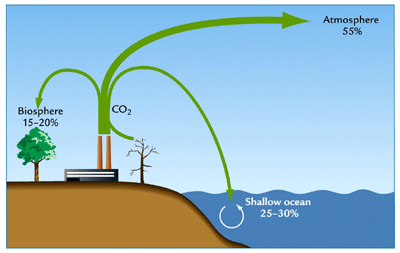 Are forest fires getting worse with climate change? In a word, yes. But, it's not all that simple. First of all, forest fires actually do a lot of good for our forests. In fact, small forest fires are good means of preventing larger ones, as the brush and dead trees on the forest floor help fires to spread very quickly. When the stuff on the bottom of the forest burns up, it cleans it up in a sense and leaves behind the taller, more resilient species. Scientists have discovered tree rings with scars in them that indicate damage from 30 (!) separate fires. Ponderosa pine trees have a very thick, fire resistant bark that helps them to weather the storm. So nature not only needs a good fire every now and then, but also has adapted to the effects of larger fires.
Are forest fires getting worse with climate change? In a word, yes. But, it's not all that simple. First of all, forest fires actually do a lot of good for our forests. In fact, small forest fires are good means of preventing larger ones, as the brush and dead trees on the forest floor help fires to spread very quickly. When the stuff on the bottom of the forest burns up, it cleans it up in a sense and leaves behind the taller, more resilient species. Scientists have discovered tree rings with scars in them that indicate damage from 30 (!) separate fires. Ponderosa pine trees have a very thick, fire resistant bark that helps them to weather the storm. So nature not only needs a good fire every now and then, but also has adapted to the effects of larger fires. As climate change advances, and it has greatly advanced, these fires are evolving from the beneficial types of fires to the dangerous sort. As forests dry up during extended droughts, and tree-killing beetles reproduce twice a year (instead of once like they used to when the winters would kill them off), and snow pack depletes due to sporadic precipitation patters, and rains become torrential and damaging, and temperatures continue to rise, and lightning strikes increase, these fires are becoming hellish. Imagine a fire burning 3.8 acres a second like the Carlton Complex fire in Washington did in 2014. At 250,000 acres this fire was the largest in state history, that is until a fire in 2015 burned more acreage yet. Out of all of the symptoms of climate change, forest fires might be the most glaring in the United States. And as global temperatures to rise, fire season is only going to continue to get longer.
The issue with forest fires is that as climate change gets worse, the fires get worse. And, as the fires get worse, climate change worsens -- it's a vicious cycle. Each tree in a forest is essentially a stick of trapped carbon, and when that tree burns, the carbon is released. The incredible natural processes that occur in our forests have a purifying effect on the air which supplies good ole oxygen to the atmosphere. With our vast forests being burned to a crisp, climate change is being accelerated and will only make the issue of forest fires worse.
Update April 12, 2016:
An article published in the New York Times today (http://www.nytimes.com/) points toward the ever lengthening fire season that climate change is causing. New Mexico has had twice as many fires this year as they did at this time last year. The first wildfire in Alaska started in February. This is highly unusual compared to typical fire seasons of years past and is indicative of the influence of the warm, dry winters that have been occurring. It appears that, sadly, McKibben was very right, climate change is going to continue to make forest fires a massive and expensive problem.

You did a really awesome job describing how climate change and forest fires are a vicious cycle. It really simplified the process and made it much easier to understand!
ReplyDeleteWhat an interesting fact about the scars found on the tree rings! I agree that the process of burning trees releases stored carbon and then that carbon contributes to climate change, which in return affects forest fires... a bad double edged sword.
ReplyDeleteI really like how you explained the benefits of small fires. It is pretty cool that they are actually beneficial in preventing larger fires. Also, I never would have guessed that different trees are less susceptible to burning, as in the ponderosa pines.
ReplyDeleteI never realized that small forest fires are a good thing. You did a great job explaining how the intensity of these fires seems to have increased. After reading this i'm very glad i don't live out west!
ReplyDeleteI have to agree with Ali on this one, you did an amazing job of explaining forrest fires, the affects and the benefits. I knew that in small amounts fires were good for the environment but I did not know to the extent that you stated that they are becoming more common.
ReplyDeleteThe most interesting part of your presentation for me was the statistics showing how almost all of the most devastating wildfires happened within the last 15 or so years. It's definitely eye-opening evidence that something is changing drastically in our natural weather system.
ReplyDeleteI thought it was eye-opening to see that map of Alaska's forest and the scar that the major fire left. Forest fires are truly a silent killer.
ReplyDelete